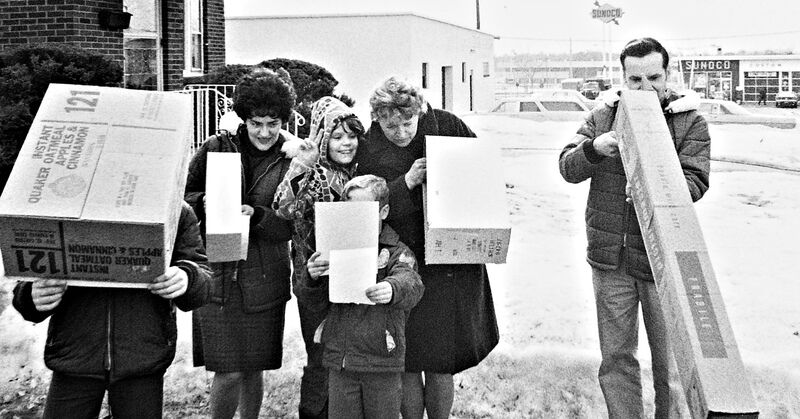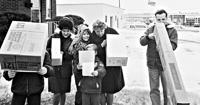Editor's Note: This column by the Gazette's Lansing Christman, a longtime area newsman and historian, on the eclipse of March 1970 appeared in the March 18, 1970 Gazette and is reproduced here.
The 1970 eclipse tracked totality just off the East Coast, and just missing Long Island. Schenectady saw the 1970 eclipse reach 0.912 percent sun coverage, according to TimeandDate.com. The upcoming April 8 eclipse will see Schenectady reach 0.973 percent coverage.
Town and Country/By Lansing Christman
March 18, 1970
We viewed the eclipse 11 days ago, and we didn't watch television to follow the phenomenon, nor did we run the risk of causing damage to our eyes by peering into the skies toward the sun.
The day was far too pleasant with spring-like warmth to spend cooped up indoors with eyes glued to a screen. Being prone to follow the easy way, or subject to sheer laziness if you prefer, we rigged up the pin hole in a cardboard device, and then, with the sun at our backs, focused the image of the eclipse onto the white surface of he second cardboard. We had the solar eclipse in miniature.

Actually, the procedure was far more simple than the one we attempted during the partial eclipse in the early 60s. That summer afternoon, we recall, we tried, without much success, to rig up the cardboard box "sunscope." The contraption, which slipped down over the head, worked after a fashion, but not with the ease and the simplicity of our March 7 arrangement.
During our lifetime, we have observed what we term three major solar eclipses from our hill acres. We checked through two generations of natural history files in a vain attempt to establish the date and the year of the earliest eclipse we had observed. (Our files have never been too orderly). But an account in the New York Times on March 8 has established the date for us. That eclipse occurred about 9 o'clock in the morning on Jan. 24, 1925. We seem to recall newspaper reports at the time telling of special train excursions to the Saugerties or Cementon areas down the Hudson where the eclipse was very near to totality, if not completely so.
One of the most vivid memories of that eclipse was the fact that the barnyard hens went back to their roosts as the moon slipped over the sun's disc and plunged the area into "darkness." The "night" was of brief duration, however, and the Plymouth Rocks were soon down from their pole perches, out of the henhouse and back into the barnyard, clucking and singing and pecking as though the returning light had brought another new day.
Since we have no inclination to stay around until the next comparable eclipse occurs in these parts 54 years from now, in the year 2024, we were most observant of the reaction of our dooryard birds to the most recent solar eclipse. (We do not have the barnyard hens anymore.)
There did appear to be an eerie twilight as the eclipse reached its zenith of 92 or 93 percent totality. A strange glow of light seemed to reflect from the dooryard, still submerged in snow. But the chickadees and nuthatches, the tree sparrows and the woodpeckers, kept at their feeding from sunflower seeds and bird seed and suet. We did note an increase in activity, as though they may have been reacting to what would appear to be an approaching early sunset They didn't stop their singing or calling, however.
The chickadees were constantly on the move, calling, and sweeping in and out of the feeder which held the sunflower seeds. We counted from 15 to 20 chickadees, flying in from the nearby cedar tree, grabbing seeds, and flying out again and back to a cedar bough, or to a limb of the doorstone mountain ash. Three sparrows were especially active, too, flocking in from the huge honeysuckle bush and from the young evergreens, to dine at their feeding stations west of the house.
We have three suet baskets suspended from a wire which leads from a corner of the woodshed to the dooryard elm. Three downy woodpeckers and a hairy were loading up for what might have seemed to hem to be an early nightfall. We heard a blue jay calling from the pasture hickory across the creek. And the cardinal sang. That was the sum total of the observations we were able to make during the brevity of the eclipse.
The eclipse, of course, did not reach maximum totality here, but where it did, one newspaper reporter described the light "as thin as that in the backroom of a tavern." That Virginia Beach reporter, we feel, deserves a stipend increase for an alertness and an awareness that could bring forth such a simple and yet such a vivid description of the dimming light that falls upon the land in the narrow path of totality.












